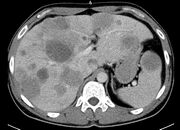Liver tumors
We understand liver tumors as tumors
- primary (benign and malignant) and
- secondary (metastases - mainly from the GIT).
Benign tumors[edit | edit source]
Pathological classification[edit | edit source]
Depending on the tissue from which liver tumors originate, they are divided into epithelial, mesenchymal, and mixed. Epithelial tumors:
- hepatocellular - nodular transformation, focal nodular hyperplasia, hepatocellular adenoma,
- cholangiocellular - gallbladder adenoma, biliary cystadenoma.
- Mesenchymal tumors
Tumors arising from the interstitium and perivascular tissues belong to this group:
- Mixed tumors
- mesenchymal hamartoma,
- benign teratoma.
Focal nodulation of hyperplasia[edit | edit source]
It is difficult to distinguish from malignancy (macroscopically and microscopically). It is formed by an accumulation of hepatocytes, Kupffer cells and small bile ducts with congested fibrous septa. It occurs 2-8 times more often in women, between the ages of 20 and 50. a year. The probability of occurrence during puberty and pregnancy increases significantly. It is therefore associated with hormonal influences and the use of hormonal contraception.
Clinical picture'
- does not manifest, usually discovered by chance,
- 80% do not exceed the size of 5 cm,
- larger ones can appear as other tumors.
Diagnosis
- ultrasound, CT and scintigraphy are used for diagnosis. biopsy to confirm.
Therapy
- for small tumors, the treatment is conservative (monitored), in the case of an unclear diagnosis, resection of part of the liver is indicated.
Therapies'
- hemangioma is one of the tumors that we usually only monitor,
- if it would lead to complications, we treat:
- res=== Liver adenoma ===
Liver adenoma, or hepatocellular adenoma, is also associated with the use of oral contraceptives, and affects mainly women aged 30-40 years. In 30%, it perforates and hemorrhages. It can turn malignant, it is a pre-cancer (possibility of malignancy 10%)!
Therapies'
- removal is indicated, as the lethality is up to 20% in case of spontaneous perforation with bleeding.
Hemangioma[edit | edit source]
Thanks to USG, today we diagnose it much more often, mainly in people aged 30-60 years, more often in women. The size varies between 4-30 cm. Ruptures are rare. It usually didn't cause the wearer any trouble before being revealed. A biopsy is never performed, there is a risk of massive bleeding.
ection for tumors over 4 cm,
- for minor embolizations of supply and drain vessels (interventional radiology).

|
Ultrasound: liver hemangioma |
Malignant tumors[edit | edit source]
We divide them into 'primary and secondary. These include hepatocellular carcinoma, fibrolamellar carcinoma, cholangiocarcinoma, hepatoblastoma, mesenchymal malignancies (angiosarcoma, fibrosarcoma) and others (carcinoid, ...).
Hepatocellular carcinoma[edit | edit source]
Hepatocellular carcinoma (HCC) is the most common primary malignant liver tumor. [1] Worldwide, hepatocellular carcinoma is the fifth most common cancer in men and the eighth in women.[2] The development of this cancer most often occurs in patients with chronic liver disease, usually in the field of cirrhosis of various etiologies (alcohol abuse, chronic hepatitis B and hepatitis C). Worldwide, hepatocellular carcinoma is the third most common oncological cause of death. [3] In our population, it is among the less common tumors with an incidence of 5-7/100 000 inhabitants'.[2] The only potentially curative therapy is surgical treatment (resection or transplantation) .
Fibrolamellar Carcinoma[edit | edit source]
Highly differentiated hepatocellular carcinoma. It is difficult to distinguish from adenoma and nodular hyperplasia. It usually mounts to cirrhosis. It is 75% resectable, so it has a better prognosis.
Cholangiogenic carcinoma[edit | edit source]
It affects the intrahepatic bile ducts. It rarely manifests as inflammation of the bile ducts. It is more common in primary sclerosing cholangitis. The main manifestation is jaundice. The prognosis is often poor, the tumor is only discovered when it is unresectable.
Liver metastases[edit | edit source]
Metastases cause up to 90% of liver malignancies. 20% are metastases from stomach cancer, 25% from colon, 50% metastases from pancreatic cancer. For solitary and innumerable (up to 3) anatomic and non-anatomical resection is indicated (mainly for colorectal cancer).
Therapy of liver tumors[edit | edit source]
Conservative[edit | edit source]
It is mainly performed for metastases from colorectal cancer and breast cancer, unless cirrhosis is significant:
- cholecystectomy (toxic cholecystitis prophylaxis), a. gastroduodenalis probing and catheter insertion,
- discontinuation of contraception or estrogen preparations in adenoma, if the adenoma does not regress → surgery,
- multiple liver metastases are treated with a local intra-arterial CHT (via a. hepatica) subcutaneously implanted port-system for 14 days, the treatment has only a minimal systemic effect.
Surgical[edit | edit source]
Surgical treatment is indicated for benign tumors (adenomas, bleeding tumors or large hemangiomas) and some malignant ones. The tumor must be limited to one lobe (T1–T3).
Surgery is the only treatment option, only 20% of patients are curatively operable (late onset of symptoms). We use the following approaches:
- transverse or median laparotomy, or an incision along the arch,
- hemihepatectomy – oriented in the line of vena cava – gallbladder,
- extended hemihepatectomy on the right - according to the ligamentum falciforme hepatis,
- resection of the liver lobe on the left - left lobe up to the lig. falciform,
- peripheral resection.
Liver metastases: Peripheral resection without orientation according to anatomical structures. Ultima ratio indicates liver transplantation in hepatocellular carcinoma, if it has not yet metastasized.
Links[edit | edit source]
Related Articles[edit | edit source]
Source[edit | edit source]
- BENEŠ, Jiří. Study materials [online]. [cit. 5.5.2010]. <http://jirben.wz.cz>.
References[edit | edit source]
- ↑ POVÝŠIL, Ctibor – ŠTEINER, Ivo – DUŠEK, Pavel, et al. Special Pathology : interaction of harmful substances with living organisms, their mechanisms, manifestations and consequences. 2. edition. Prague : Galen, 2007. 430 pp. pp. 209-210. ISBN 978-807262-494-2.
- ↑ a b BRŮHA, Radan. Hepatocellular carcinoma [online]. ©2012. [cit. 2015-11-03]. <https://web.archive.org/web/20160331222721/http://zdravi.e15.cz/clanek/postgradualni-medicina/hepatocelularni-karcinom-466724>.
- ↑ CICALESE, Luca. Hepatocellular carcinoma [online]. ©2015. [cit. 2015-11-03]. <https://emedicine.medscape.com/article/197319-overview>.
References[edit | edit source]
ČEŠKA, Richard, et al. Intern. 1. edition. Prague : Triton, 2010. 855 pp. ISBN 978-80-7387-423-0.




